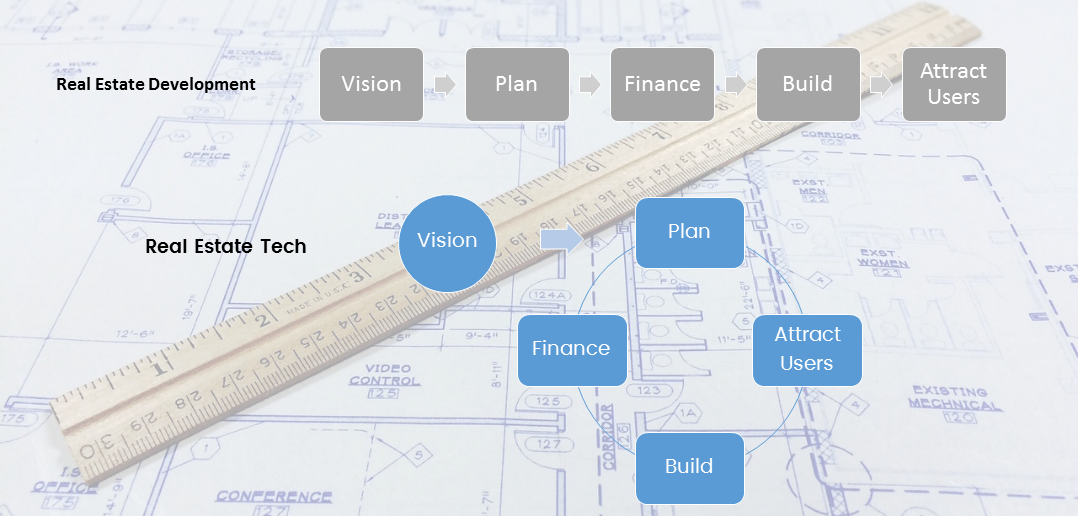Developing Property vs PropTech
A Process Comparison
There are two types of development in the world of property. The first is ages old – the physical real estate development process. An investor eyes an opportunity, develops a plan, arranges capital, builds the structure, and then attracts users of that property for profit.
The other is newer and it’s called proptech. Also a development process, proptech shares a common starting point with physical property development: it all starts with a vision.
However, the two processes vary drastically from there.
Vision. Plan. Finance. Build. Attract Users. Profit!
While real property is often referred to as a cyclical market, the lifecycle of a single asset starts out in a linear process. If you don’t have a properly underwritten plan in place, you can’t move on to financing. If you don’t have the proper financing, you don’t begin construction. Most importantly, until construction makes it possible, you cannot send tenants into your property for mutual benefit of tenant and landlord. Each step in the process is unlocked by completing the previous step to satisfaction:
Vision. …??? … Profit!
The lifecycle of new software development is quite different. While also starting with a vision for creating a fixture in the future, the remaining steps like planning, attracting users, building the tech, and financing growth will happen in a more unpredictable order. While a property developer wouldn’t dream of breaking ground where they haven’t received the proper financing to complete their project, it’s common practice for tech entrepreneurs to “take the leap” and try to figure things out before hitting the ground.
When we started StackSource a little over a year ago, we had a simple vision for streamlined, digital access to commercial real estate loans for every property owner in the world. As we dove deeper, built some tools, and attracted some users, we quickly realized that we needed to refine the plan. Some property owners wanted to click their way directly to a loan comparison of matched lenders, and others wanted the platform to help manage an existing set of lender relationships and loans in their portfolio. We drove adoption on our platform knowing that we didn’t yet have the investment necessary to service those clients for long. Fluidly moving back and forth between refining the plan, building more product features, and fundraising was a necessity –and the end result is far better product than it would have been creating a rigid plan, raising money, and then building exactly what we imagined in the beginning. Yes, that means a different risk profile, but where the potential reward is higher as well, as we build something new for a huge industry use-case of financing real estate.
Who cares?
Forward-leaning real estate investors are increasingly looking to innovative technology companies to give them that edge on their competition. Some software platforms are helping investors recognize opportunities, others aid in streamlining internal operations to make teams more efficient, and still others increase the value of existing portfolio assets. While understanding all of the underlying technology nuances is not always critical to becoming a strong technology user, understanding the development process when working with a tech start-up, especially at an early stage, will set expectations properly and can help set the stage for a successful partnership. Users of new technology solutions can often play a strategic role in helping that start-up build their offering, and sometimes there’s an opportunity to build a stronger relationship with that start-up – as an advisor, investor, or strategic partner. If you sit on the sidelines waiting for the start-up to complete all of the steps and drive adoption across the industry, you may miss the opportunity to be an early adopter, which often comes with many soft benefits beyond just using the software, like gaining shares in the start-up through investment or advisory, or forming a deep relationship with an up and coming industry fixture.
It seems a safe bet that for proptech, the next decade will see a far higher rate of innovation than the last century. With the amount of start-ups attacking the sector, the increasing amount of global investment, and the benefits starting to be reaped by companies who have implemented a smart technology strategy, there will be an increasingly sharp divide between real estate companies who learn to adapt to the changing physical and digital world and those that stay in the dark.
See what else we’re thinking and writing about at Blog.StackSource.com, or follow us at Twitter.com/StackSource



